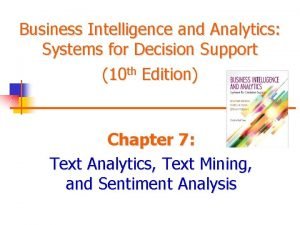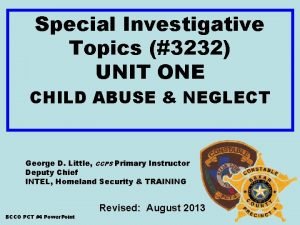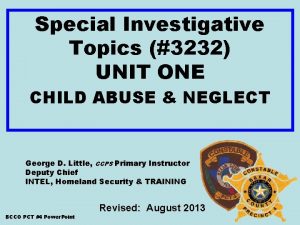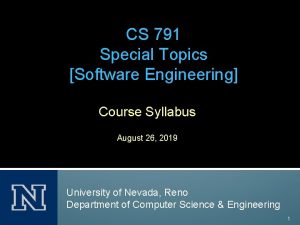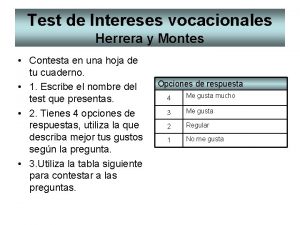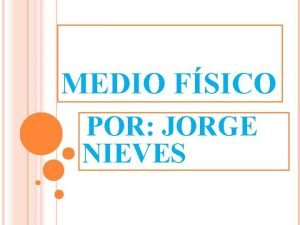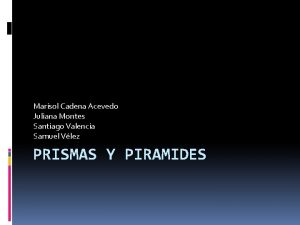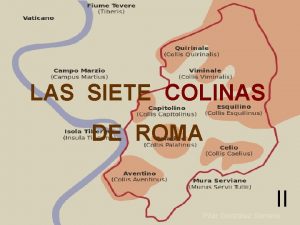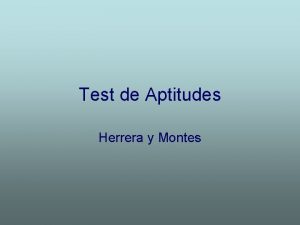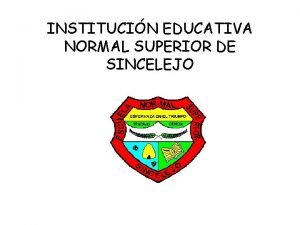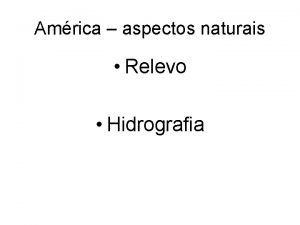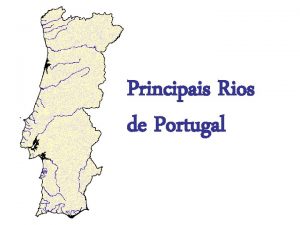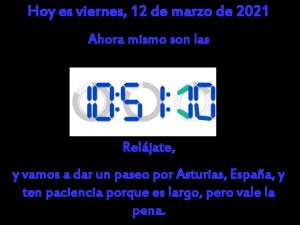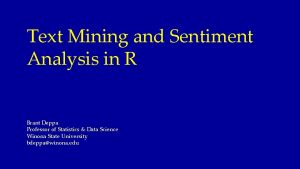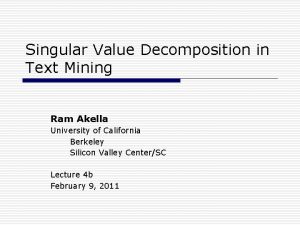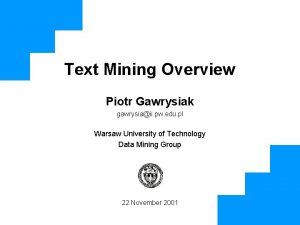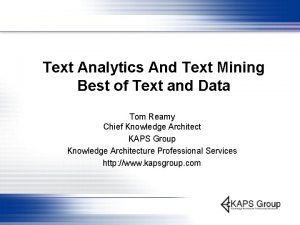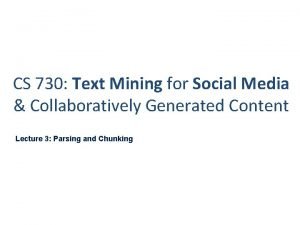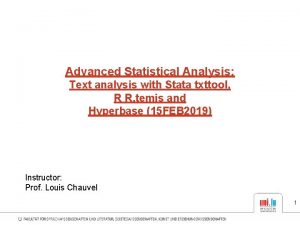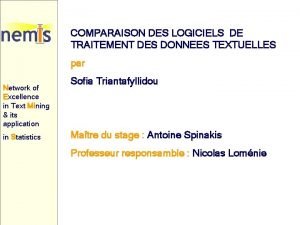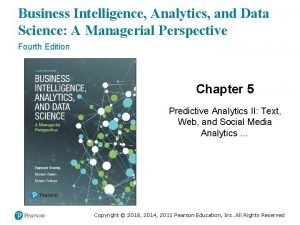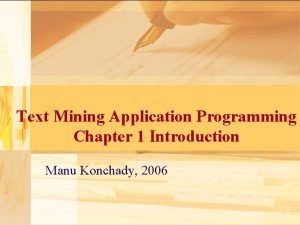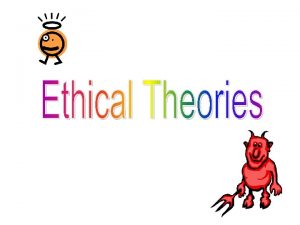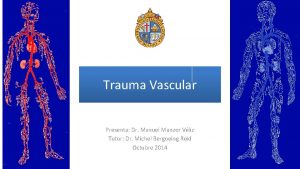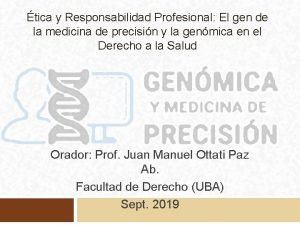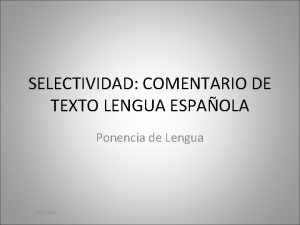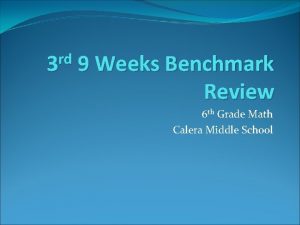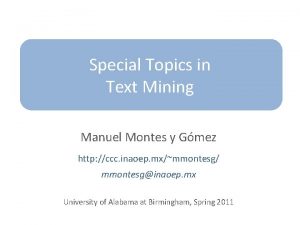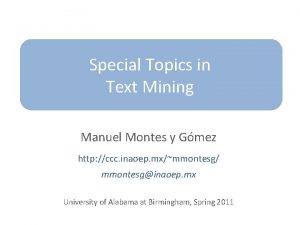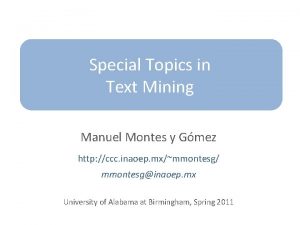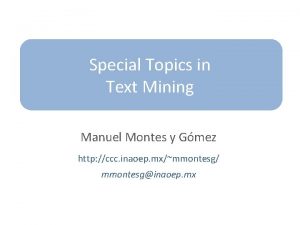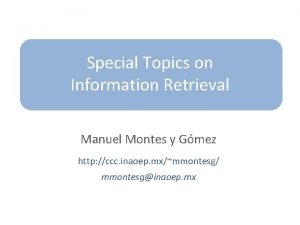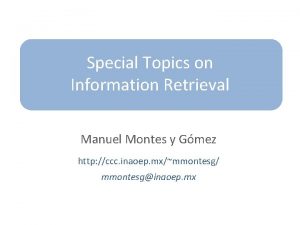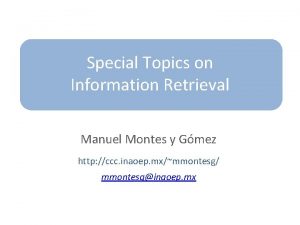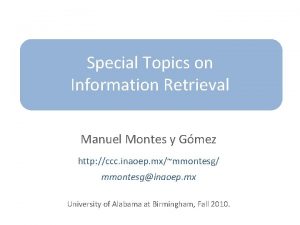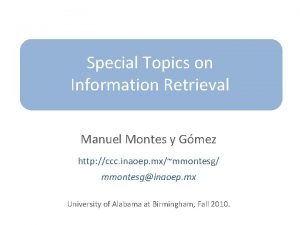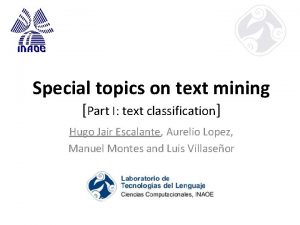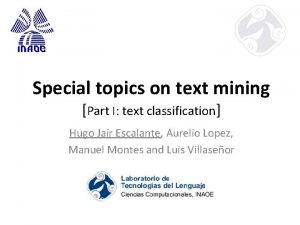Special Topics in Text Mining Manuel Montes y











































- Slides: 43

Special Topics in Text Mining Manuel Montes y Gómez http: //ccc. inaoep. mx/~mmontesg/ mmontesg@inaoep. mx University of Alabama at Birmingham, Spring 2011

Introduction to text classification

Agenda • The problem of text classification • Machine learning approach for TC • Construction of a classifier – Document representation – Dimensionality reduction – Classification methods • Evaluation of a TC method Special Topics on Information Retrieval 3

Classification Given a universe of objects and a pre-defined set of classes assign each object to its correct class • Input: – A description of an instance, x X, by a vector of measurements; where X is the instance space. – A fixed set of categories: C={c 1, c 2, …cn} • Output: – The category of x: c(x) C, where c(x) is a categorization function whose domain is X and whose range is C. Special Topics on Information Retrieval 4

Textual-related tasks Problem Objects (instances) Categories Tagging words in context POS tags WSD words in context word senses PP attachment sentences parse trees Language identification Text languages Text classification documents topics • Text classification is the assignment of free-text documents to one or more predefined categories based on their content Special Topics on Information Retrieval 5

Text classification applications • Web pages organized into category hierarchies • Journal articles indexed by subject categories • Patents archived using International Patent Classification • Patient records coded using international insurance categories • News events tracked and filtered by topics Other applications? • E-mail message filtering (spam detection) Other non-thematic applications?

Manual classification • Very accurate when job is done by experts – Different to classify news in general categories than biomedical papers into subcategories. • But difficult and expensive to scale – Different to classify thousands than millions • Used by Yahoo!, Looksmart, about. com, ODP, Medline, etc. Ideas for building an automatic classification system? How to define the classification function? Special Topics on Information Retrieval 7

Hand-coded rule based systems Experts Knowledge engineers Labeled documents New document Rule 1, if … then … else Rule N, if … then … Document’s category Classifier • Main approach in the 80 s • Disadvantage knowledge acquisition bottleneck – too time consuming, too difficult, inconsistency issues Special Topics on Information Retrieval 8

Machine learning approach (1) • A general inductive process builds a classifier by learning from a set of preclassified examples. – Determines the characteristics associated with each one of the topics. Ronen Feldman and James Sanger, The Text Mining Handbook Special Topics on Information Retrieval 9

Machine learning approach (2) Have to be Experts? Experts Which algorithm? Inductive process New document How to represent documents? Special Topics on Information Retrieval Labeled documents (training set) How large has to be? Rules, trees, probabilities, prototyes, etc. Document’s category Classifier 10

Representation of documents • First step is to transform documents, which typically are strings of characters, into a representation suitable for the learning algorithm. • The most common used document representation is the bag of words. – Documents are represent by the set of different words in all of the documents – Word order is not capture by this representation – There is no attempt for understanding their content Special Topics on Information Retrieval 11

Representation of documents Vocabulary from the collection (set of different words) t 1 … tn d 1 d 2 All documents (one vector per document) : wi, j dm Weight indicating the contribution of word j in document i. Which words are good features? How to select/extract them? How to compute their weights? Special Topics on Information Retrieval 12

Preprocessing • Eliminate information about style, such as html or xml tags. – For some applications this information may be useful. For instance, only index some document sections. • Remove stop words – Functional words such as articles, prepositions, conjunctions are not useful (do not have an own meaning). • Perform stemming or lemmatization – The goal is to reduce inflectional forms, and sometimes derivationally related forms. am, are, is → be car, cars, car‘s → car Special Topics on Information Retrieval 13

Term weighting - two main ideas • The importance of a term increases proportionally to the number of times it appears in the document. – It helps to describe document’s content. • The general importance of a term decreases proportionally to its occurrences in the entire collection. – Common terms are not good to discriminate between different classes Special Topics on Information Retrieval 14

Term weighting – main approaches • Binary weights: – wi, j = 1 iff document di contains term tj , otherwise 0. • Term frequency (tf): – wi, j = (no. of occurrences of tj in di) • tf x idf weighting scheme: – wi, j = tf(tj, di) × idf(tj), where: • tf(tj, di) indicates the ocurrences of tj in document di • idf(tj) = log [N/df(tj)], where df(tj) is the number of documets that contain the term tj. Special Topics on Information Retrieval 15

Dimensionality reduction • A central problem in text classification is the high dimensionality of the features space. – Exist one dimension for each unique word found in the collection can reach hundreds of thousands – Processing is extremely costly in computational terms – Most of the words (features) are irrelevant to the categorization task How to select/extract relevant features? How to evaluate the relevance of the features? Special Topics on Information Retrieval 16

Two main approaches • Feature selection • Idea: removal of non-informative words according to corpus statistics • Output: subset of original features – Main techniques: document frequency, mutual information and information gain • Re-parameterization – Idea: combine lower level features (words) into higher -level orthogonal dimensions – Output: a new set of features (not words) – Main techniques: word clustering and Latent semantic indexing (LSI) Special Topics on Information Retrieval 17

Document frequency • The document frequency for a word is the number of documents in which it occurs. • This technique consists in the removal of words whose document frequency is less than some specified threshold • The basic assumption is that rare words are either non-informative for category prediction or not influential in global performance. Special Topics on Information Retrieval 18

Mutual information • Measures the mutual dependence of the two variables – In TC, it measures the information that a word t and a class c share: how much knowing word t reduces our uncertainty about class c The idea is to select words that are very related with one class Special Topics on Information Retrieval 19

Information gain (1) • Information gain (IG) measures how well an attribute separates the training examples according to their target classification – Is the attribute a good classifier? • The idea is to select the set of attributes having the greatest IG values – Commonly, maintain attributes with IG > 0 How to measure the worth (IG) of an attribute? Special Topics on Information Retrieval 20

Information gain (2) • Information gain Entropy • Entropy characterizes the impurity of an arbitrary collection of examples. – It specifies the minimum number of bits of information needed to encode the classification of an arbitrary member of the dataset (S). • For a binary problem: Greatest uncertainty 1 bit to encode the class No uncertainty always positive/negative not need to encode the class Special Topics on Information Retrieval 21

Information gain (3) • IG of an attribute measures the expected reduction in entropy caused by partitioning the examples according to this attribute. – The greatest the IG, the better the attribute for classification – IG < 0 indicates that we have a problem with greater uncertainty than the original – The maximum value is log C; C is the number of classes. Special Topics on Information Retrieval 22

Classification algorithms • Popular classification algorithms for TC are: – Naïve Bayes • Probabilistic approach – K-Nearest Neighbors • Example-based approach – Centroid-based classification • Prototype-based approach – Support Vector Machines • Kernel-based approach Special Topics on Information Retrieval 23

Sec. 13. 2 Naïve Bayes • It is the simplest probabilistic classifier used to classify documents – Based on the application of the Bayes theorem • Builds a generative model that approximates how data is produced – Uses prior probability of each category given no information about an item. – Categorization produces a posterior probability distribution over the possible categories given a description of an item.

Sec. 13. 2 Bayes’ Rule for text classification • For a document d and a class cj • Estimation of probabilities Prior probability of class cj Smoothing to avoid overfitting Probability of occurrence of word ti in class cj

Naïve Bayes classifier • Assignment of the class: • Assignment using underflow prevention: – Multiplying lots of probabilities can result in floatingpoint underflow – Since log(xy) = log(x) + log(y), it is better to perform all computations by summing logs of probabilities rather than multiplying probabilities Special Topics on Information Retrieval 26

Comments on NB classifier • It is a very simple classifier which works very well on numerical and textual data. • It is very easy to implement and computationally cheap when compared to any other classification algorithms. • One of the major limitations of this classifier is that it performs very poorly when features are highly correlated. • Concerning text classification, it fails to consider the frequency of word occurrences in the feature vector. Special Topics on Information Retrieval 27

KNN – initial ideas • Do not build explicit declarative representations of categories. – This kind of methods are called lazy learners • “Training” for such classifiers consists of simply storing the representations of the training documents together with their category labels. • To decide whether a document d belongs to the category c, k. NN checks whether the k training documents most similar to d belong to c. – Key element: a definition of “similarity” between docuemnts Special Topics on Information Retrieval 28

KNN – the algorithm • Given a new document d: 1. Find the k most similar documents from the training set. • Common similarity measures are the cosine similarity and the Dice coefficient. 2. Assign the class to d by considering the classes of its k nearest neighbors • Majority voting scheme • Weighted-sum voting scheme Special Topics on Information Retrieval 29

Common similarity measures • Dice coefficient • Cosine measure wki indicates the weight of word k in document i

Selection of K Problems caused by the value of k? How to select a good value? Special Topics on Information Retrieval 31

The weighted-sum voting scheme Other alternatives for computing weights? Special Topics on Information Retrieval 32

KNN - comments • One of the best-performing text classifiers. • It is robust in the sense of not requiring the categories to be linearly separated. • The major drawback is the computational effort during classification. • Other limitation is that its performance is primarily determined by the choice of k as well as the distance metric applied. Special Topics on Information Retrieval 33

Centroid-based classification • This method has two main phases: – Training phase: it considers the construction of one single representative instance, called prototype, for each class. – Test phase: each unlabeled document is compared against all prototypes and is assigned to the class having the greatest similarity score. • Different from k-NN which represent each document in the training set individually. How to compute the prototypes? Special Topics on Information Retrieval 34

Calculating the centroids • Centroid as average • Centroid as sum • Centroid as normalized sum • Centroid computation using the Rocchio formula Special Topics on Information Retrieval 35

Comments on Centroid-Based Classification • Computationally simple and fast model – Short training and testing time • • Good results in text classification Amenable to changes in the training set Can handle imbalanced document sets Disadvantages: – Inadequate for non-linear classification problems – Problem of inductive bias or model misfit • Classifiers are tuned to the contingent characteristics of the training data rather than the constitutive characteristics of the categories Special Topics on Information Retrieval 36

SVM • A binary SVM classifier can be seen as a hyperplane in the feature space separating the points that represent the positive from negative instances. – SVMs selects the hyperplane that maximizes the margin around it. – Hyperplanes are fully determined by a small subset of the training instances, called the support vectors. Special Topics on Information Retrieval Support vectors Maximize margin 37

Non-linear SVM • What about classes whose training instances are not linearly separable? – The original input space can always be mapped to some higher-dimensional feature space where the training set is separable. • A kernel function is some function that corresponds to an inner product in some expanded feature space. x 2 0 Special Topics on Information Retrieval x 38

SVM – discussion • The support vector machine (SVM) algorithm is very fast and effective for text classification problems. – Flexibility in choosing a similarity function • By means of a kernel function – Sparseness of solution when dealing with large data sets • Only support vectors are used to specify the separating hyperplane – Ability to handle large feature spaces • Complexity does not depend on the dimensionality of the feature space Special Topics on Information Retrieval 39

Evaluation of text classification • What to evaluate? • How to carry out this evaluation? – Which elements (information) are required? • How to know which is the best classifer for a given task? – Which things are important to perform a fair comparison? Special Topics on Information Retrieval 40

Evaluation – general ideas • Performance of classifiers is evaluated experimentally • Requires a document set labeled with categories. – Divided into two parts: training and test sets – Usually, the test set is the smaller of the two • A method to smooth out the variations in the corpus is the n-fold cross-validation. – The whole document collection is divided into n equal parts, and then the training-and-testing process is run n times, each time using a different part of the collection as the test set. Then the results for n folds are averaged. Special Topics on Information Retrieval 41

Performance metrics • Considering a binary problem Classifier YES Classifier NO Label YES Label NO a c b d • Recall for a category is defined as the percentage of correctly classified documents among all documents belonging to that category, and precision is the percentage of correctly classified documents among all documents that were assigned to the category by the classifier. What happen if there are more than two classes? Special Topics on Information Retrieval 42

Micro and macro averages • Macroaveraging: Compute performance for each category, then average. – Gives equal weights to all categories • Microaveraging: Compute totals of a, b, c and d for all categories, and then compute performance measures. – Gives equal weights to all documents Is it important the selection of the averaging strategy? What happen if we are very bad classifying the minority class? Special Topics on Information Retrieval 43
 Difference between text mining and web mining
Difference between text mining and web mining Making connections
Making connections Text analytics and text mining
Text analytics and text mining Text analytics and text mining
Text analytics and text mining Strip mining vs open pit mining
Strip mining vs open pit mining Strip mining vs open pit mining
Strip mining vs open pit mining Difference between strip mining and open pit mining
Difference between strip mining and open pit mining Mining multimedia databases
Mining multimedia databases Mining complex types of data in data mining
Mining complex types of data in data mining Dena schlosser
Dena schlosser Special investigative topics 3232
Special investigative topics 3232 Software engineering course syllabus
Software engineering course syllabus Cimo de uma montanha ou colina
Cimo de uma montanha ou colina Test de herrera y montes
Test de herrera y montes Dr. christian montes
Dr. christian montes Montes maoke
Montes maoke Juliana valencia montes
Juliana valencia montes 7 montes de roma
7 montes de roma Vertiente oceano glacial artico
Vertiente oceano glacial artico En general que tan suertudo te consideras
En general que tan suertudo te consideras Escudo de la normal superior de sincelejo
Escudo de la normal superior de sincelejo Sabrina montes
Sabrina montes Montes escandinavos continente
Montes escandinavos continente Diseño correlacional
Diseño correlacional Vertente do artico
Vertente do artico Os principais rios de portugal
Os principais rios de portugal Asturias verde de montes y negra de minerales
Asturias verde de montes y negra de minerales David montes gallego
David montes gallego Text mining and sentiment analysis in r
Text mining and sentiment analysis in r Svd text mining
Svd text mining Text mining meaning
Text mining meaning Text mining
Text mining Text mining
Text mining Txttool
Txttool Logiciel de text mining
Logiciel de text mining Text mining social media
Text mining social media Catbeller
Catbeller Text mining
Text mining Text mining application programming
Text mining application programming Claire andre and manuel velasquez
Claire andre and manuel velasquez Vascular
Vascular Juan manuel ottati paz
Juan manuel ottati paz Manuel vicent comentario de texto 2021
Manuel vicent comentario de texto 2021 Manuel found a wrecked trans-am
Manuel found a wrecked trans-am



